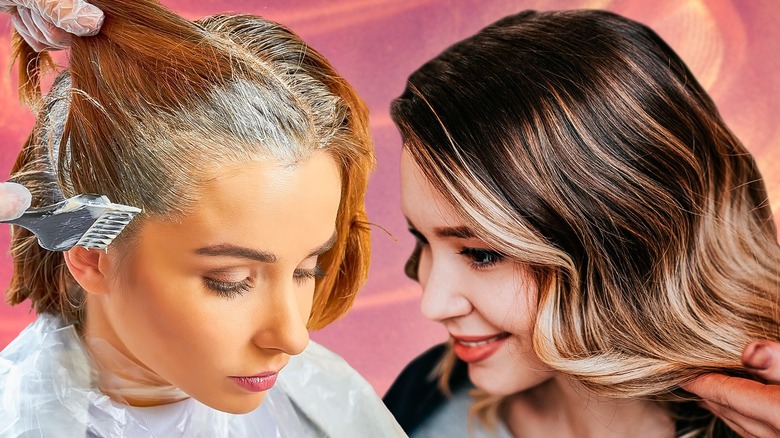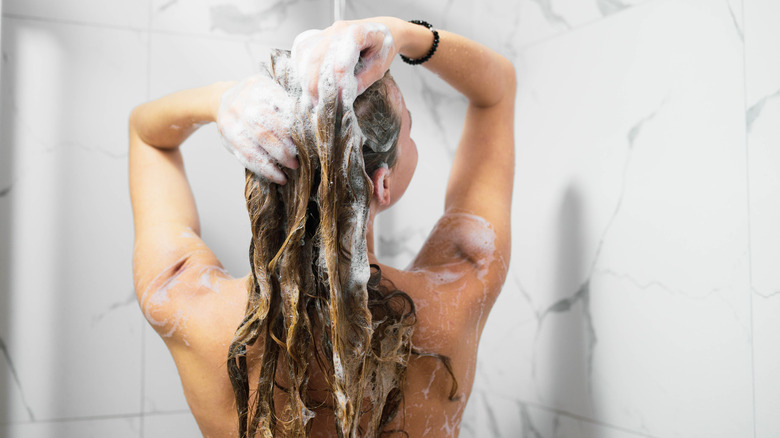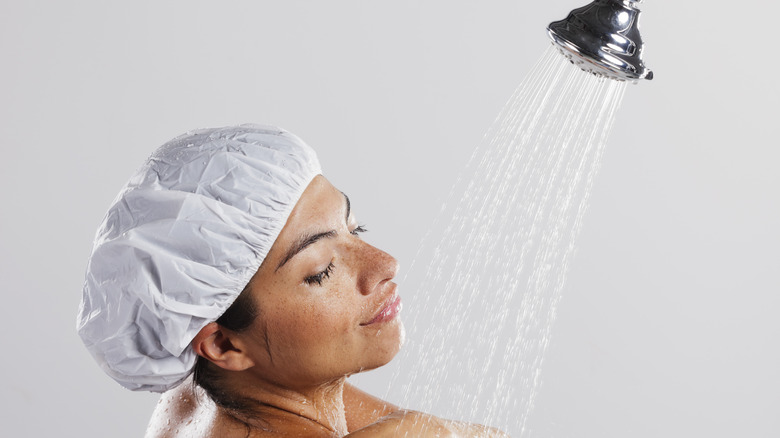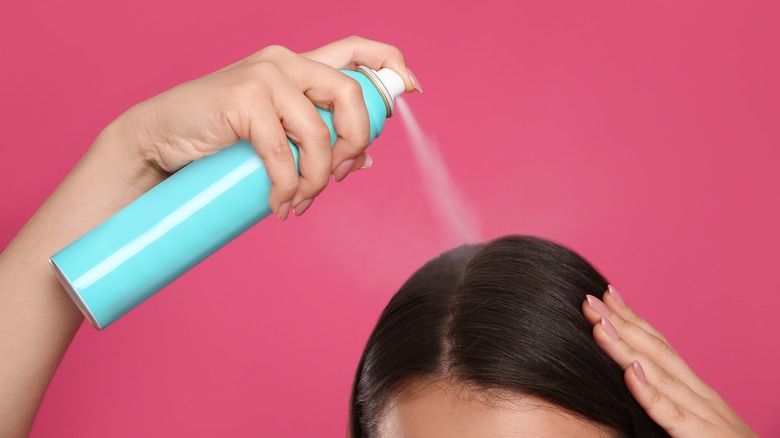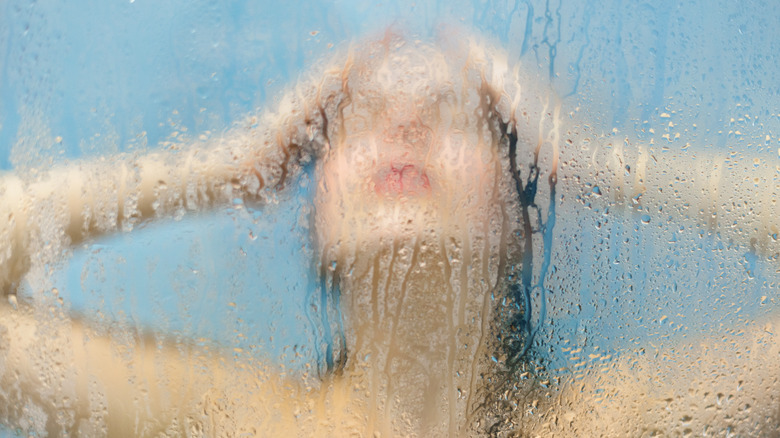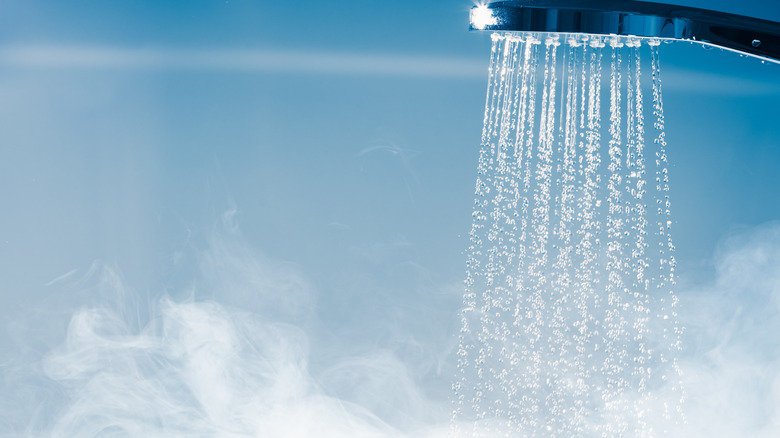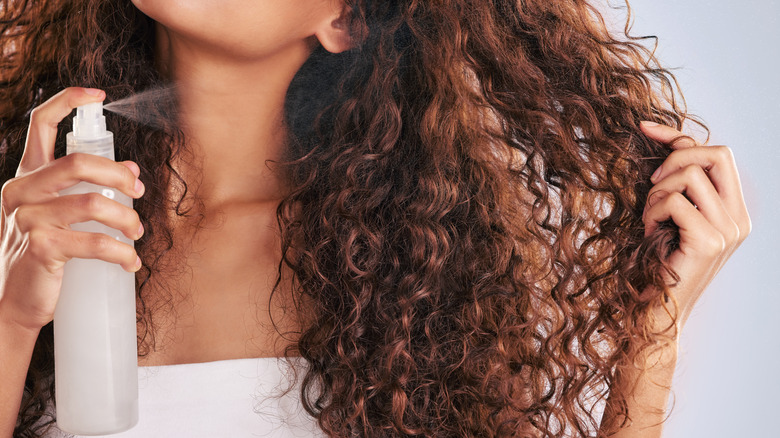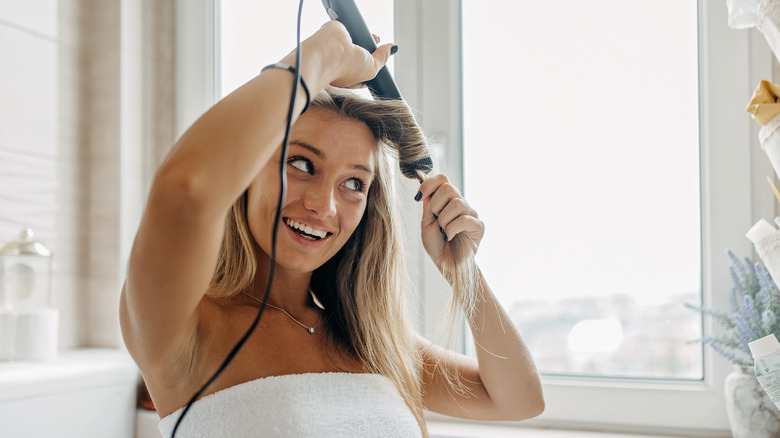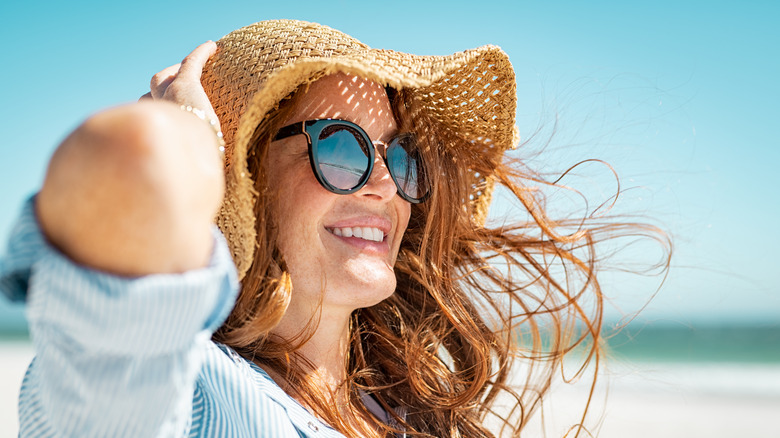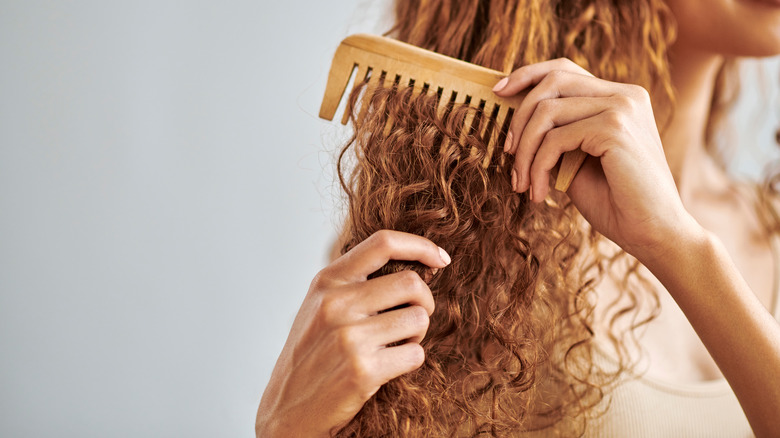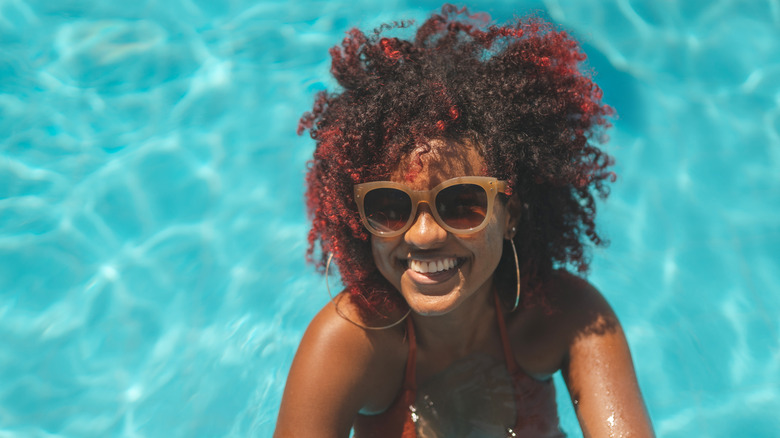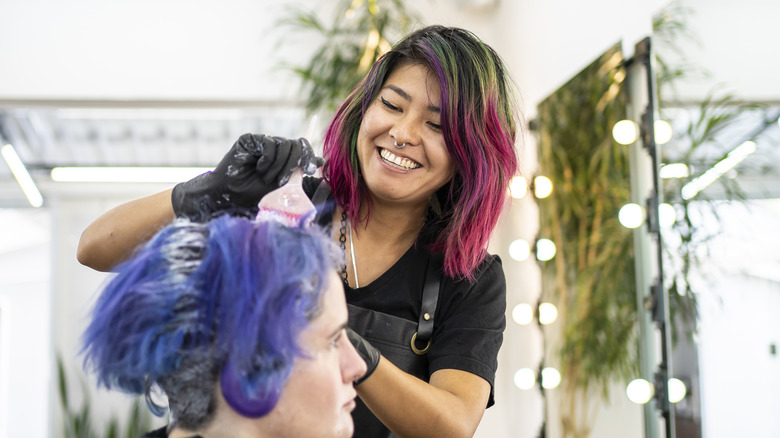12 Tips To Make Hair Color Last And Prevent Fading
Whether you're opting for a casual brunette, a fiery red, a fun blond, or some other magical color under the rainbow — like blue or green — coloring your hair comes with one big drawback: It fades over time. Some hair colors fade faster than others, but luckily, there are things you can do to slow down the fade. First, let's look at some facts.
How long your hair color lasts depends, first of all, on what type of dye you're using. Temporary color is meant to quickly wash out of your hair, usually in one or two shampoos. Semi-permanent color will last a little bit longer, depending on how often you're washing your hair, of course. It can wash out within a few weeks to a month, and will often start to fade after just a few shampoos. Then there is permanent hair color, which isn't exactly permanent either. If you want a hair color that will stick around for more than a month, opt for permanent, but you'll still need to take special precautions to keep the color from fading. There are also different ingredients in some products, like those with an oil base — which are supposed to take longer to fade. If you're tired of your hair color looking drab after a shampoo or two, we have some tips that can help you keep your color vibrant for longer.
Don't wash your hair too soon after coloring
While you do need to wash the hair dye out of your hair, for multiple reasons, you shouldn't shampoo your hair again for at least two to three days. While it may seem enough to rinse the dye out with water alone until it runs clear, the chemicals from hair color can stay stuck on your follicles. By shampooing your hair, you help remove all of that excess hair dye and prevent those chemicals from sticking around to wreak havoc on your hair. Some of the negative aspects of leftover hair color include dryness, which can lead to brittleness and breakage. Aside from that, leftover color in your hair can rub off on clothing and bedding, leaving behind stains that are hard to remove.
However, after that initial shampoo, you want to wait a few days before you wash your hair again. The color is setting into your hair strands for the long haul, and washing it too soon can make your hair color start to fade quickly. If you're worried about needing to wash your hair, skip your trips to the gym for those first couple of days after a fresh color, or find alternative ways to keep your scalp dry and feeling fresh.
Don't wash your hair too often either
While you may like to shower daily, shampooing every day can quickly lead to fading. Then again, you don't really need to wash your hair every single day anyway. Founder of Drybar, Alli Webb, who is also a professional hair stylist, told WebMD, "I have always said, 'It's fine to go a few days without shampooing.'" When your hair gets too oily, too dry, or too dirty, that's a good indication that it's time to wash your hair. Angela Lamb, MD. told WebMD, "Regardless of how your hair feels, though, don't go longer than 14 days, ever."
Color-treated or not, your best bet is to wash your hair every two to three days. There are things you can do to extend that time, just as there are times when you may need to wash it more often (like after working outside in the dirt or sweating a lot after a workout). You can still shower even if you're not washing your hair — simply put on a shower cap to keep your tresses dry.
Start using a dry shampoo
One of the ways you can deal with oily hair in between washing is by using dry shampoo. There are myriad options out there when it comes to dry shampoo, from aerosol to non-aerosol, overnight treatments, and on-the-go formulations. Then you have various scent options and picks for darker or blond hair. In addition, there are dry shampoos made to help keep your color-treated hair from fading. The ingredients in your dry shampoo work to absorb oils from your hair and scalp so that your hair looks clean again. Some dry shampoos use alcohol as the absorbing agent, while others use starch.
You can experience a build-up of residue from dry shampoo, so it shouldn't be your only way of cleansing your hair. Simply use it as a way to cut down on how often you need to shampoo each week. If you wash your hair Monday and use dry shampoo Wednesday, then you may be able to get to Friday before you need to shampoo again. So you're only risking that fade-inducing shampoo twice a week instead of daily.
Pick the right regular shampoos too
Not all shampoos are created equally. Some of them are more likely to strip your hair. This is good if you don't like the color you chose and want it fade fast, but not so good when you're trying to get your hair color to last as long as possible. Some shampoos that are likely to strip your color include clarifying formulas. Clarifying shampoos strip a lot from your hair — including natural oils. While they are a great choice to use prior to a fresh color job, it's better to avoid them at other times. You also want to avoid anything that has "reset" in its description — these tend to work similarly to clarifying shampoos.
You do want to pick shampoos and conditioners that are designed to help your color stay brighter for longer, especially products that are made specifically for color-treated hair. Some simply help keep the color from fading while others have some tint in them that keeps the color looking fresh. You may also want shampoos that help remove brassiness if you're going blond, such as a blue shampoo.
Avoid hard water
If you have hard water in your home, you could be damaging your color every shampoo even if you're only washing your hair a couple times a week. This type of water is rich in hard minerals that can bond to your hair and suck out the color. A couple of common minerals found in hard water are magnesium and calcium. Hard water won't just fade your dye job. It can also lead to dryer hair, no matter how healthy your hair is and even if you don't color it.
To battle the effects of hard water, the easiest thing to do (albeit pricey) is to invest in a water softener system. You can also invest in a filter for your shower head that helps block out some of those hard minerals before they make it onto your hair. If you have city water that is treated with chlorine, these filters can help keep that nasty chemical from ruining the color of your hair as well.
And turn your shower temp down
Hot things are not good for color-treated hair, and that includes hot water. As much as you may not be a fan of cold showers, they're a blessing to your hair. The colder the better when it comes to not stripping hair color or natural oils from your hair. If you've dyed your hair with a temporary dye, it's going to wash out, and wash out quickly with hot water shampoos. If you've used a semi-permanent or permanent product and you use hot water to rinse, you could rinse some of the color out as well. Once the color has set in for a couple of days, subsequent shampoos with hot water can make it fade, which isn't good if you're intending to keep that color.
Not only can that hot shower make your color fade faster, but it can also dry out your hair. You don't have to take a cold shower — just aim for warm for your body and try to rinse your hair in cooler water.
Give your hair special treatment
Speaking of dry hair, dry and unhealthy hair is likely to lose its color more quickly, so you want to do what you can to keep your hair and scalp happy. Never skip the conditioner when you're washing your hair or even just getting it wet — this will help keep those hair follicles moisturized so that you can prevent drying and fading. You can also do deep moisturizing treatments on your hair, whether you're using something like an oil treatment or a hair mask.
When it comes to picking the right treatment for your hair, be sure to get something that is made for color-treated hair. You don't want to invest in a hair mask to moisturize your hair and keep it from fading only to find out it had clarifying qualities that have now stripped a bunch of your color and left you with exactly the opposite of what you were looking for. It's also important to remember that the ingredients in many hair color products have a way of drying your hair out and causing it to be brittle, so using a hair mask about a week after a fresh dye job can be good for your hair.
Use protection when styling with heat
When it comes to heat, your styling tools can also dry your hair out and dull your color. Celebrity colorist Justin Anderson told makeup.com by L'Oreal, "Adding heat to your styling routine — whether that's from using a blow-dryer, curling iron, flat iron and even washing your hair with extra hot water — can cause your hair to appear a little dull and lackluster over time," adding, "These things can unfortunately cause your hair color to fade much faster, too."
So, how do you keep using your hot tools for styling without damaging your hair? You can invest in products that help protect your hair from heat, such as heat protectant sprays. You can also opt to avoid heat tools altogether by air drying your hair or using curlers and a setting spray in place of your curling iron. Because, as Anderson also told L'Oreal, "Going heatless is really the only way to truly avoid fading." While you may need to wait a little longer for your hair to dry naturally than you would with a blow dryer, the wait could be worth the extra time between dye jobs!
Protect your hair from the sun
There is another large source of heat out there that has the potential to make your hair color fade: the sun. While it may not be the heat of the sun that damages your hair, those UV rays can surely cause issues with fading and making your hair even dryer. While you may like the sunkissed highlights you get from extended time on the beach during the summer, that free hair coloring is actually hair damage. Luckily, there are ways to protect your hair from the damaging effects of the sun and still be able to enjoy time outdoors.
The first thing you can do is invest in a hat. A wide-brimmed sunhat offers a stylish way to not only protect your hair but also the skin on your scalp, face, and even your shoulders (depending on the width of the brim). If hats aren't your thing or you're planning to spend a good deal of your time in the water, consider investing in some products for your color-treated hair, like gels and sprays that contain SPF protection.
Invest in the right styling products
Speaking of styling products, those made for color-treated hair, beyond your shampoo and conditioner, can do a lot to protect your hair from loss of color and all of the things out there that are trying to leach the hue from your locks. We've already talked about avoiding clarifying products, but sulfates are another ingredient that can lead to fading. Be sure to read the ingredients on your styling products, from your favorite sculpting gels to the oils you use to keep it shiny and moisturized.
Not only do you want products that protect you from UV rays, but you also want to look for moisturizing products to keep your hair healthy. Pick products that are meant to mend and heal your hair, and that add more shine and life to it. Be sure to avoid harmful ingredients, like most sulfates, or any products that contain alcohol (which is extremely drying to your hair and even your scalp, and can lead to issues like dandruff and itching).
Watch out for chlorinated water
Another thing you want to protect your hair from when it comes to keeping your faux color fresh is chlorine. Whether you have chlorinated water at home or you're planning to go for a dip in the pool or lounge in the hot tub, chlorine is not good for your hair. Even uncolored hair can get dry and discolored from chlorinated water. Chlorine, after all, is bleach, and we use bleach not only to kill germs but also to whiten whites and remove stains from things. The color in your hair is treated just like a stain on your shirt by that chlorinated water, and it will start to suck the dye right out and leave you with a dry faded mess.
While you may not want to go swimming with a cap on your head, there are some products you can use to help protect your hair from chlorine damage. You can use a leave-in conditioner pre-swim to help coat your hair with a protective layer — be sure to do this on damp hair. And, if you don't have any leave-in conditioner on hand, don't fret. You can also take a quick shower before you jump in the pool so that your hair is already wet and will absorb less chlorinated water.
Visit the salon for a touchup
You can also prevent fading by heading to the salon for touchups not only when your roots begin to show but also when you see some fading coming on. When it comes to how often you should go to the salon for touchups, that depends on what you need done. If you've been coloring your hair for a while, you'll likely need touchups more often than someone who's always had virgin hair. While you may be able to get away with six weeks in between touchups with healthy hair that hasn't had a lot of chemicals on it, you may find yourself needing to visit the salon more often if you regularly color your hair or do other treatments like perms and straighteners.
If your hair is looking dull and lifeless, make an appointment with your stylist so that they can get you a fresh look. Your hair specialist may use something like a refresher hair paste that helps boost your color without completely recoloring your hair. At home, you can try a hair gloss or even some items from the kitchen. For instance, coffee is good for refreshing brown hair, while champagne can freshen blond, and cranberry juice is great for reds.
